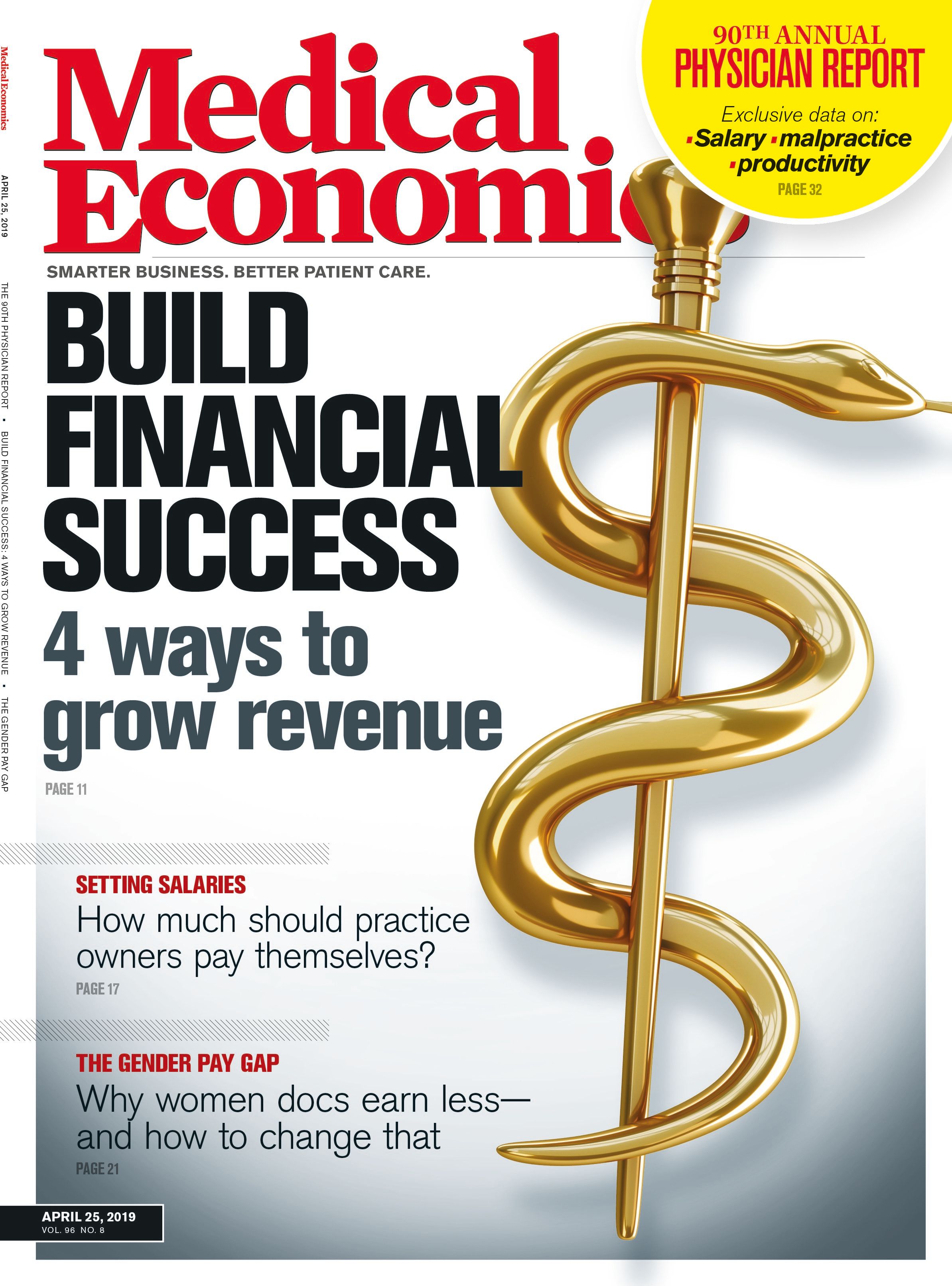Publication
Article
Medical Economics Journal
How to drive revenue growth in your medical practice
Author(s):
Plotting a financial path to practice success
©patpitchaya/stock.adobe.com

The challenges to sustaining a successful medical practice are numerous-declining reimbursements, government regulations, and third-party interference, among others, all play a role. But even in the face of these obstacles, many practices continue to hold their own financially. When asked about the financial state of their practice as part of the Medical Economics 2019 Physician Report, 22 percent of respondents said their practice is doing better than a year ago, 52 percent are doing about the same, and 26 percent are doing worse.
So what makes the difference between a booming practice and one stuck in neutral, or worse? The majority of physicians doing better than the previous year attributed their success to seeing more patients, enabling them to increase revenue. Yet many physicians work long hours already and wonder how seeing more patients or making other operational changes is even possible.
As a starting point, physicians should figure out where their practice ranks compared to others of their size. “Look at the financials and benchmark them to get an idea whether you are performing as an average practice should,” says David Zetter, CHCC, CHBC, senior healthcare consultant for Mechanicsburg, Pa.-based Zetter Healthcare and member of the National Society of Healthcare Business Consultants (NSHBC). Look at the number of patients seen per day, the average reimbursement levels, and revenue per provider to figure out where the practice is lagging.
Once physicians know where to focus their efforts, financial improvements can often be generated by increasing staffing, improving productivity, embracing value-based care, or renegotiating payer contracts.
Add staff to increase patient capacity
Adding staff can increase patient capacity. And while it means higher operating costs, in many cases, the extra help pays for itself in multiple ways. Sterling Ransone, MD, FAAFP, a family physician in Deltaville, Va., had reached a point where he couldn’t see any more patients in a day. When he couldn’t find another physician willing to relocate to the area, he opted to hire a nurse practitioner instead. Now, he is able to focus on more of the chronically ill patients who require complex care.
“For us, it was mainly about capacity, because when we didn’t have [a nurse practitioner], we were super busy,” says Ransone, whose wife is also a physician in the practice. “Part of the benefit to me is knowing that patients get to see someone and that I’ll be involved in the mix for their care. It’s been well worth it to my personal bottom line.”
This includes the benefit of having more time with his family during non-business hours. “In the early years, I took calls 24/7,” he says. “Once we started hiring midlevels, they could take some of the calls for us, freeing us to travel with our kids or be places the phone doesn’t reach.”
Similarly, Marc Price, DO, a primary care physician practicing in Malta, N.Y., found that whenever he took time away from the office, he was losing money because there was no patient revenue being generated. Adding a non-physician provider has helped with office efficiency and finances, even though those weren’t the only reasons he made the hire.
“I hired one not specifically for revenue, but more for lifestyle and service to patients,” says Price. “When it comes to income, they make more than what you pay them.”
Price says the physician assistant helps him keep up with patient messaging, prescription refills, lab reports, and other administrative duties, freeing up more of his time to spend with patients.
Another staff addition that can pay for itself is a scribe. Ransone has been using one for 15 years, and says he went from averaging about 20 patients per day to 23-24, with between 22 and 23 being the break-even point on cost.
“The length of time required for any one patient was shortened and all the extraneous computer stuff was being done by someone else,” says Ransone. “I could get in more patients and wasn’t spending all my time following up on referrals and other administrative tasks. It’s been as good for my patients as it has been for my sanity.”
Larry Brooks, AIA, principal of Practice Flow Solutions in Roswell, Ga., and member of NSHBC, says that patients want an efficient visit, and a scribe helps accomplish that not only in reduced wait times, but also in patient satisfaction.
“Using a scribe, a doctor can spend eight to 10 minutes with eye contact,” says Brooks. “A patient feels a lot better about that than a 15-minute visit with the doctor looking at a computer one-third of the time.”
When looking at staffing that can boost revenue, don’t forget about billing, says Zetter. “Not following up on denied claims or unpaid claims can be costly,” he says. “Revenue growth is about understanding the whole practice-can you add patient revenue, ancillary services, or something like chronic care management [CCM]? If you have a patient population that needs CCM, bringing in another staff member to handle the paperwork for that is a no-brainer to get that $40 a month per patient.”
Increase productivity
Experts say there are often pockets of wasted time in a physician’s schedule or inefficiencies in how patients flow through the practice. Eliminating these means more patients can be seen during the workday.
A small practice using a receptionist to triage patients might not have time to check in patients if the phone lines are busy. Or maybe vendors or drug reps are tying up the time of the front desk staff, even to the point where the doctor is coming out to talk to them for a few minutes. That time isn’t accounted for in the schedule, so it quickly creates backlogs and reduces the number of patients that can be seen in an average day, says Zetter.
Brooks says doctors often spend their time on non-productive tasks, such as walking a patient out after an appointment or trying to figure out which patient is next in line to be seen. And if the office space is laid out poorly, the doctor can waste time walking between exam rooms.
“These are all small things, but if you are doing them 30 or 40 times a day, eliminating them might save enough time for another office visit,” says Brooks.
An optimal design for a practice with four exam rooms is two rooms across from each other, not four in a line. That cuts down the amount of time the doctor spends going from room to room. The layout should also help patients navigate their way back to the front desk without the need for an escort, so the doctor can quickly move on to the next patient, says Brooks.
Poor scheduling can also contribute to practice inefficiency. Too many patients with chronic conditions scheduled together can create backlogs, while too many patients with simple problems can create gaps.
“There’s a fine line to getting the right type of patient mix at a rate that keeps the doctor busy,” says Brooks. “Make sure there are always one or two patients ready, not six or eight waiting an hour.”
Increase revenue with value-based contracts
As Medicare and private payers continue to incentivize value-based care, experts say physicians need to understand how these contracts can benefit their practice. “If you have Medicare patients, you have the ability to gather information right now on some of the value-based principles and measures Medicare is looking at,” says Zetter.
Assemble the information and compare it to similar practices to evaluate practice performance. Then go to each payer and ask if they have any quality-based incentives appropriate for the practice.
When potential earnings have been determined, practices can make a return-on-investment calculation based on how much work is required to collect and report the data. “If it makes sense, go ahead and sign up, because you might be able to earn several thousand dollars a quarter, with no cost to sign up,” says Zetter.
Price’s practice takes part in the Medicare Shared Savings Program’s Comprehensive Primary Care Plus model, is a Level 3 Patient-Centered Medical Home (PCMH), and has one value-based contract with an insurer. “Don’t pass up value-based opportunities or think they are too daunting,” says Price. “Look at how you can do it with maximum efficiency and capture the rewards.”
Obtaining certification for PCMH status can be costly, but Price found a program from an insurer that would pay for the transformation of his practice. “They paid the fee and I reap the benefits,” he says.
Many risk-sharing contracts will require either adopting an Alternative Payment Model (APM) or becoming part of an Accountable Care Organization (ACO), says Pam Ballou-Nelson, RN, Ph.D, principal consultant with the Medical Group Management Association. She says researching any potential partners is vital.
“The way to lose money in a value-based contract is to join any group and not understand how they are structured or how they are making sure care management and coordination are done so they can share savings,” Ballou-Nelson says.
Practices must study patient data to understand how to succeed in value-based care, no matter the practice model. “If your EHR cannot produce data or registries and can’t produce outcome data, then you can’t improve what you are doing,” Ballou-Nelson points out. “If you are paid on controlling the risk of a population, you better know what the risk scores are and make sure those patients get into the office and do everything they need to do.”
Negotiate better payer contracts
Physicians who think they can’t negotiate better payer contracts are usually wrong, says Zetter, but it takes preparation. “Everybody can negotiate. Many people don’t because they don’t think they have any leverage,” he says.
Leverage starts with understanding the value the practice offers the payer. Ballou-Nelson says practices have to evaluate their patient data so they can tell a story about what they bring to the payer, pointing out how they excel in areas that the payer values.
“If you are not bringing value to the payer and understanding what the payer needs you to report on, you are of no value to the payer,” she says. “Look at payers’ report cards on you. If you are not doing a good job in the metrics that are important to them, there is no reason they would give you a better contract.”
Zetter suggests examining two years’ worth of claims data. In some cases, this will reveal that a practice isn’t executing the financial basics, leaving money uncollected through denied claims or services that were billed incorrectly. “Fix the internal stuff first,” he says. “There is no reason to negotiate with you if you are throwing money away.”
Patient satisfaction is becoming a bigger factor in how payers view physicians, and if a practice isn’t measuring that, they may be missing out on leverage with payers, Zetter says. “A practice needs to find out what they need to do better with patients and act on it,” he adds. “If you have high scores on surveys, payers love that.”
If physicians want to improve their practice finances and be successful, they also have to improve their attitude, says Ballou-Nelson. “Doctors that feel they are victims of the system or of payers are often the ones struggling,” she says. “Those with more optimistic views on how to make changes based on the reality of the landscape are the ones that tend to be more successful. I worked with a physician who was struggling and his attitude was, ‘It’s all a game.’ Well, if you don’t play the game, you are not going to get the money.”






